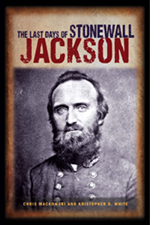 Review by Michael Aubrecht
Review by Michael Aubrecht
The Free Lance-Star T&C (8/23)
In May of 1863, General Thomas “Stonewall” Jackson launched a surprise attack on Union General Joseph Hooker’s army. The result would be remembered as one of the Confederacy’s most significant and bittersweet victories. Anxious to end Federal occupation in Virginia, Jackson’s troops successfully flanked the unsuspecting army and swarmed its camps near Chancellorsville. Unfortunately, their impatient commander took a catastrophic risk that would tragically alter the course of history.
As darkness fell on the first night of the battle, Jackson’s own men of the 18th North Carolina Infantry accidentally fired upon him. The incident occurred after the general and his staff had trotted well beyond their own lines, in an effort to survey the retreating enemy’s position. As the silhouetted group of riders returned to the main road, they were mistaken for Yankee cavalry.
Without a warning, two volleys rang out in the darkness and the general fell from his saddle. Bleeding profusely, Jackson had been hit by three shots. One ball was lodged in the palm of his right hand, and the other two penetrated his left arm. The damage was devastating.
This story of a legendary soldier’s accidental shooting, premature death and subsequent commemoration is the basis for a new book titled “The Last Days of Stonewall Jackson.”
A handsome paperback, this book is truly a homegrown title. Written by NPS Volunteer Chris Mackowski and Ranger/Historian Kris White, it was designed by The ID Entity’s Jackson Foster and funded by the Friends of Fredericksburg Area Battlefields.
According to John Hennessy, chief of interpretation at the National Park Service, this book is the first in what will be a series of publications to come out jointly under the NPS and FOFAB logo. Also in the pipeline are titles on the Wilderness and Ellwood, Chancellorsville, Chatham, and Clara Barton. Each will be created locally and released through Thomas Publications.
Despite having a familiar premise, “The Last Days of Stonewall Jackson” presents a fresh look at a well-documented event. Unlike most Jackson biographers, Mackowski and White narrowed their focus to examining the finale of this extraordinary soldier’s life. In doing so, they have produced a definitive and well-rounded study that tells the complete story of Jackson’s demise, and more notably, how it is remembered today.
As the book’s beginning outlines, “friendly-fire” was only the beginning of the general’s deadly trial.
Threatened by artillery, Jackson was taken from the field on a stretcher and treated at a nearby hospital encampment at Wilderness Run. It was there that Dr. Hunter Holmes McGuire was able to successfully amputate his injured limb. Despite suffering from shock and a severe loss of blood, the general survived the risky surgery as the Battle of Chancellorsville raged on.
After the Union army threatened to retake the area, General Lee ordered Jackson’s staff to move him to the Fairfield plantation at Guinea Station. He was evacuated by ambulance and placed in an outbuilding on the property. Initially, Jackson looked to make a full recovery, but he later developed an incurable case of pneumonia and died on May 10, 1863 surrounded by staff and family.
As word spread throughout the South of Jackson’s untimely death, many supporters of the Confederacy fell into despair. General Robert E. Lee refused to accept the mortality of his fiercest officer and reportedly told his aides, “He has lost his left arm, but I have lost my right.” Even today, many historians credit the death of “Stonewall” as the key turning point in the War Between the States.
In addition to presenting the tragic events resulting in Jackson’s last breath, “The Last Days of Stonewall Jackson” also provides readers with an examination of how the moment has been memorialized through the years. Beyond the battlefield, Jackson’s legacy remains a celebrated part of Southern culture, as death elevated him to a mythical-like status.
Each year, thousands of tourists come to Spotsylvania County to relive the last days of “Stonewall.” Some visit the Chancellorsville Battlefield Visitor’s Center and walk the dirt path where Jackson was wounded, while others follow the Ambulance Route to Guinea Station in order to stand at the bedside where he died. Visitors may also travel to historic Ellwood where Jackson’s personal chaplain, the Reverend Beverly Tucker Lacy, reportedly buried his commander’s severed limb in the family cemetery.
In an email interview with me, Chris Mackowski explained the mindset behind “The Last Days of Stonewall Jackson.” He wrote, “There’s a lot of mythology and romanticism that now surrounds Jackson. We wanted to peel some of that back. Even people well-familiar with the story of Jackson’s death are going to find a few surprises in this book because we had access to some never-before-published material that provides new details.”
He added, “Not only do we tell the story of Jackson’s death, we tell the story of the shrine, too. The building has an interesting story of its own, which we really wanted to highlight. People find the place profound and sublime. We wanted to give readers a glimpse behind the scenes.”
At 100 pages, this book is an easy read and features a nice collection of photographs and illustrations that complement the narrative. Many will appreciate the timeline of events that is included, which highlights key moments in the life of Thomas Jackson, from his childhood at Jackson’s Mill, to his days as a student at West Point and later, as a professor at the Virginia Military Institute. Beyond Jackson’s personal and military milestones, the authors also include a timeline for the restoration and establishment of the “Stonewall” Jackson Shrine.
“The Last Days of Stonewall Jackson” will appeal to a large audience, as serious students of the Civil War will appreciate the newfound details and casual readers will gain a much better understanding of why the life and death of “Stonewall” Jackson still matters today.
Book available at Eastern National bookstores ($6.95)
Updated: Tuesday, 25 August 2009 11:33 AM EDT
Permalink | Share This Post






